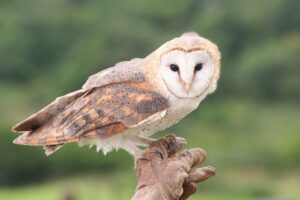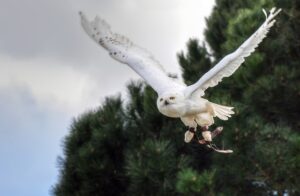
Greetings, readers. Today we learn a little more about two kinds of owls as we continue our series, Caring for Mother Nature, by my friend, author and naturalist, Peggy Sias Lantz (click her name to visit her website).
The Second Book of Owls
by Peggy Lantz
Recently, I wrote about the three species of owls you were most likely to see and hear in the Central Florida area. But I told you there were five different species of owls actually found in Florida. In that previous article, I described them all, but here is a bit more about the two you rarely see: the Burrowing Owl and the Barn Owl. I have very little experience with them except to have seen them on rare occasions in the wild.
Burrowing Owls
Surprisingly, the Burrowing Owl seems to be not very wild. It puts up with a lot of human activity, inhabiting golf courses or airport grassy areas, as well as pastures and agricultural areas. Also surprisingly, it lives on the ground and nests in burrows. Yes, in holes in the ground. They usually find a hole that something else made or alongside or in a pipe, rather than digging their own. But they also scratch it out a little bigger or even dig their own, where they lay their eggs.
The Burrowing Owl is small, about nine inches tall, like the Screech Owl, with longer legs than most owls. They’re both diurnal and nocturnal; a lot of its activities occur during the day. It feeds mostly on insects and some small rodents and amphibians.
I have most often seen them in south Florida, standing upright beside their burrow on a golf course.
Barn Owls
The Barn Owl is the most secretive owl. I have seen them a very few times, always hiding in the rafters in a corner of a barn or old abandoned building while I’m prowling a woods somewhere.

Their roosting and nesting sites are most often in a building or cave, or in a secluded tree cavity. They’re totally nocturnal and eat mostly rodents, sometimes amphibians and reptiles.
Barn Owls have a strange monkey-like face, are light brown, and stand 15 or 16 inches tall, and my book says they make eerie hissing and screeching sounds, which I have never heard.
All five owl species can be found throughout Florida and are year-round residents.
Surprise owl sighting
The most exciting owl sighting I ever had was in Minnesota. I was speeding along a major highway, snow on the ground, when I realized a Snowy Owl was flying alongside my car over the grasses beside the road. I swerved off the highway, braking, and got a surprised look from the driver of the car that had been behind me. I sat there a moment, memorizing the sight of that beautiful huge white bird, which I will never see in central Florida.

—END—
Thanks for reading!
Your writer on the wing,
Charlene







Linda Goddard
Another lovely post! This time on two of the five owl of Florida!
Often in the evening, I hear an owl hoot out into the night and love, love, love this sound!
Again, my gratitude to you and to your friend, Peggy!